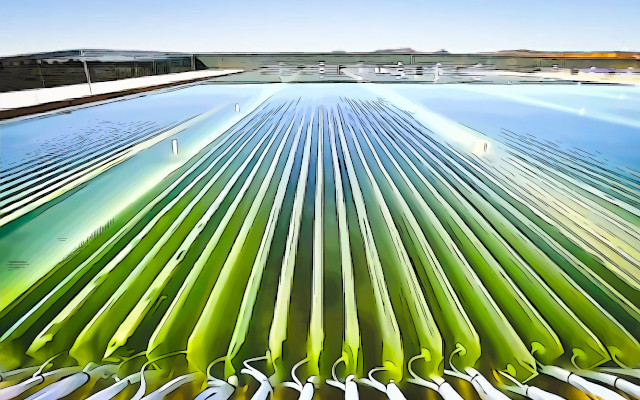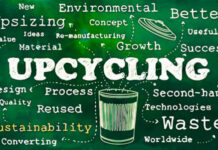Carbon farming and upcycling-the key words for mitigating climate change and bringing the circular economy to life (1,2)-find unparalleled expression on Earth’s surface in algae and microalgae.
These primitive life forms not only sequester huge volumes of carbon in the atmosphere, but rapidly convert CO2 into organic matter and so into food, feed, fertilizer, and biofuels.
ABECCS(Algae-based Bioenergy with Carbon Capture and Storage) is one of the most interesting applications of the blue bioeconomy. Producing protein and energy by devouring carbon dioxide.
1) Mitigating climate change with negative emission systems. IPPC
‘Mitigation of Climate Change,’ the 2022 report of IPCC(The Intergovernmental Panel on Climate Change), confirms what was noted in 2014. (3) The probability of containing global temperature increase within the +2°C limit is associated with 116 possible scenarios, where:
- 87 percent of the assumptions are based on the adoption of BECCS(Bioenergy with carbon capture and storage) systems,
- 67 percent of these scenarios postulate that such systems will express at least 20 percent of the world’s primary energy by 2100.
Producing zero-emission energy (e.g., solar, biomethane), according to IPCC, is not enough to mitigate global warming. Also needed are negative-emission systems, that is, systems that can absorb more carbon than they emit.
2) Carbon storage. The limits of terrestrial ecosystems
Trees and plants (e.g., hemp, bamboo) are key tools to combat climate change through carbon storage. (4) Moreover, a scientific study published in Nature (Terrer et al., 2021) showed that there is a variable, even negative, relationship between plant biomass development and Soil Organic Carbon(SOC) storage in soils. (5)
Observation of 108 experimental studies showed that soil carbon storage (SOC) decreases when plant biomass is strongly stimulated by CO2. The reduction in soil performance appears to be related to increased nutrient uptake by some plants, perhaps also related to the agronomic practices adopted. Therefore, SOC projections may need to be revised.
3) Microalgae superstars in carbon storage.
Microalgae represent one of the most promising solutions for both producing food of high nutritional value (6,7) and contributing to climate change mitigation. Also through the creation of carbon storage systems that can exceed the limits of terrestrial ecosystems, due to the following.
3.1) Relationship between bioenergy produced and space used
The production of bioenergy through microalgae requires ten times less area than is needed to produce the same amount of energy through land plants.
3.2) Water consumption and growing conditions.
Microalgae cultivation consumes less water than many terrestrial crops. With two substantial differences:
- the use of fresh water, while possible, is not required,
- nutrients can be brought in through wastewater from other industrial processes.
3.3) Speed of growth
Photosynthesis is used by microalgae to absorb CO2, water, sunlight and produce energy. But unlike many plants, microalgae do not need to develop stems and/or roots.
Therefore, the energy of microalgae is mainly devoted to cell division, which enables their constant replication at a much faster rate than in trees.
Therefore, too, aquatic microalgae have been identified as fast-growing species whose carbon fixation rates are higher than those of terrestrial plants.
3.4) Prosperity in high CO2 environments.
Some microalgae species are able to thrive in high CO2 environments and effectively remove CO2 at a rate 10 to 50 times that of terrestrial plants. One acre (0.4 ha) of algae can remove up to 2.7 tons per day of CO2.
Chlorella
stands out in its great resistance to harsh environmental conditions, showing excellent growth rates at different concentrations of CO2 (15 percent), as well as in the presence of nitrogen and sulfur oxides (NOx, SOx), gases responsible for smog. (8)
4) Upcycling of CO2 for industrial algae production. The example of Pond Technology
Pond Technologies
(Canada) has developed a system for upcycling CO2 emitted from various industrial plants (e.g. power plants, oil refineries, cement factories, food industries, etc.).
Conventional bioreactors, connected to infrastructure, transfer emissions from smokestacks to tanks where algae consume carbon dioxide and release oxygen into the atmosphere, and also produce biomass with different destinations.
5) Negative-emission biofuels from microalgae.
ABECCS(Algae-based Bioenergy with Carbon Capture and Storage) systems use marine microalgae to produce negative-emission energy, that is, capable of fulfilling the requirements specified by IPPC (see section 1 above).
The advantages of biofuels thus produced, compared with other materials falsely represented as such, are:
- effectively negative carbon footprint (unlike, for example, palm oil. See footnote 9),
- absence of competition with food production, in inputs (e.g., fresh water) and outputs (as is the case with corn crops for biofuel use, among others). (10)
6) Integrated agriculture, forestry and algae cultivation systems.
Integrated systems of agriculture, forestry and algae cultivation are also promising–from different perspectives, economic and environmental–for the production of food, feed and bioenergy. Of note in this regard is a study (Beal et al., 2018) on an ABECCS project where a 121-hectare algae planting was combined with a 2,680-hectare eucalyptus forest. (11)
Eucalyptus biomass powerscombined heat and power plants (CHP) with subsequent carbon capture and storage(CCS). Some of the captured CO2 is used for algae cultivation; the rest is sequestered. Biomass combustion provides CO2, heat and electricity, while promoting algae cultivation.
6.1) Integrated systems, protein and energy output.
The integrated system under analysis (Beal et al., 2018) produced as much protein as soybeans while generating 61.5 TJ of electricity and sequestering 29,600 t/year of CO2. The energy generated was greater than that consumed, the water footprint (fresh water) about the same as that of soybeans.
The economic results were found to be equal to those of a soy monoculture, due to the availability of product combinations that can include the provision of algal biomass-with substitute functions for fishmeal, i.e., soybean-with corresponding carbon credits. And an appreciable environmental value for respecting biodiversity in forest area.
7) Interim Conclusions
Algae and microalgae represent a practical solution for biomass production with various destinations (food, feed, fertilizer and biostimulants, biofuels) and bioenergy, with a negative carbon footprint.
The integration of microalgae production into agricultural and industrial systems also appears promising for the prospects of upcycling process side streams (e.g., co-products) into food ingredients.
Dario Dongo and Giulia Pietrollini
Notes
(1) Dario Dongo, Giulia Pietrollini. Carbon farming , Council green light for EU certification of carbon credits in agriculture. GIFT (Great Italian Food Trade). 21.12.22
(2) Dario Dongo. Upcycling, the high road of research and innovation. GIFT (Great Italian Food Trade). 1.1.23
(3) IPPC, The Synthesis Report of the Fifth Assessment Report, (2014) AR5 Synthesis Report: Climate Change 2014 – IPCC
(4) Marta Strinati. The power of hemp to sequester carbon at the center of Hemp-30. GIFT (Great Italian Food Trade). 10.1.23
(5) Terrer, C., Phillips, R.P., Hungate, B.A. et al. (2021). A trade-off between plant and soil carbon storage under elevated CO2. https://www.nature.com/articles/s41586-021-03306-8 Nature 591, 599-603. https://doi.org/10.1038/s41586-021-03306-8
(6) Dario Dongo. ProFuture, microalgae to feed the planet. The EU research project. GIFT (Great Italian Food Trade). 18.6.19
(7) Dario Dongo, Andrea Adelmo Della Penna. Algae and microalgae for food use in Europe, the ABC. GIFT (Great Italian Food Trade). 14.11.22
(8) S.P. Singh, Priyanka Singh (2014). Effect of CO2 concentration on algal growth: A review. Renewable and Sustainable Energy Reviews. Volume 38, 2014, Pages 172-179, ISSN 1364-0321, https://doi.org/10.1016/j.rser.2014.05.043.
(9) Dario Dongo, Giulia Caddeo. Biodiesel from palm oil. Antitrust condemns ENI. Égalité. 8.2.20
(10) Marta Strinati. Rising prices and food crisis in wartime. Background in iPES FOOD report. GIFT (Great Italian Food Trade). 10.5.22
(11) Beal, Colin M.; Archibald, Ian; Huntley, Mark E.; Greene, Charles H.; Johnson, Zackary I. (2018). Integrating Algae with Bioenergy Carbon Capture and Storage (ABECCS) Increases Sustainability. Earth’s Future. doi: 10.1002/2017EF000704
(12) Dario Dongo. Upcycling, the high road of research and innovation. GIFT (Great Italian Food trade). 1.1.23









